Civics - Class 9
Democratic Politics - I
Chapter 4: Working of Institutions
Intext Questions:
Question 1: Which points, other than the ones mentioned above, do you recall about these institutions from the previous class? Discuss in class.
Answer:
The institutions mentioned are the President
of India, the Prime Minister of India and the Parliament. Besides the points mentioned, they have many
other functions.
The primary duty of the president is to preserve, protect and defend the constitution and the
law of India per Article 60. The president appoints the Chief Justice of India and other judges
on the advice of the chief justice.
The Prime Minister chairs the meetings of the Cabinet. He coordinates the working of different
departments. In case of any disagreement between two or more departments, the decision of the Prime
Minister is final. The Prime Minister supervises the functions of various ministries.
Parliament has four main functions: legislation (making laws), representation (acting on behalf
of voters and citizens), scrutiny (examining the government), and formation of government.
i) It has the power to impeach the President, the Vice-President, the judges of the Supreme Court and
the High Court.
(ii) It can also punish its members or outsiders for the breach of privilege or
its contempt.
(iii) All the members of the parliament participate in the election of the Vice-President.
Question 2: Can you think of a major decision made by your state government? How were the Governor, the Council of Ministers, the state assembly and the courts involved in that decision?
Answer:
An example of a major decision is given
here. There have been many others. A major decision taken by the Uttar Pradesh State Government in 2008
was not to allow the Reliance Group to open their retail shops selling vegetables and fruits in the
state, as it would harm the interests of the small traders selling these items. This order was approved
by the Council of Ministers and the order was promulgated by the Governor. Since it did not involve
finances, it was not raised in the State Assembly. The courts were in no way involved, as it did not
have any Constitutional implications.
Question 3: Is every Office Memorandum a major political decision? If not, what made this one different?
Answer:
Not every office memorandum is a major political decision, most of them are routine in nature. This office memorandum relating to reservation for the Socially and Economically Backward Classes (SEBC) in government services was different because it affected all the sections of society, the SEBC's in a positive way and the other classes in a negative way. This reservation issue was a major source of controversy for several years and led to many agitations and court cases.
Question 4: Now I can see clearly! That is why they talk of Mandalisation of politics. Don’t they?
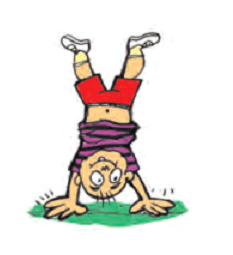
Answer:
In the Lok Sabha elections of 1989, the Janata Dal Party in its election manifesto promised that if
voted to power it would implement the Mandal Commission Report. With this announcement Mandalisation of
politics took place and voting was influenced by the Mandal Commission Report.
Question 5: Reservation debate was such an important issue during 1990-91 that advertisers used this theme to sell their products. Can you spot some references to political events and debates in these Amul Butter hoardings?
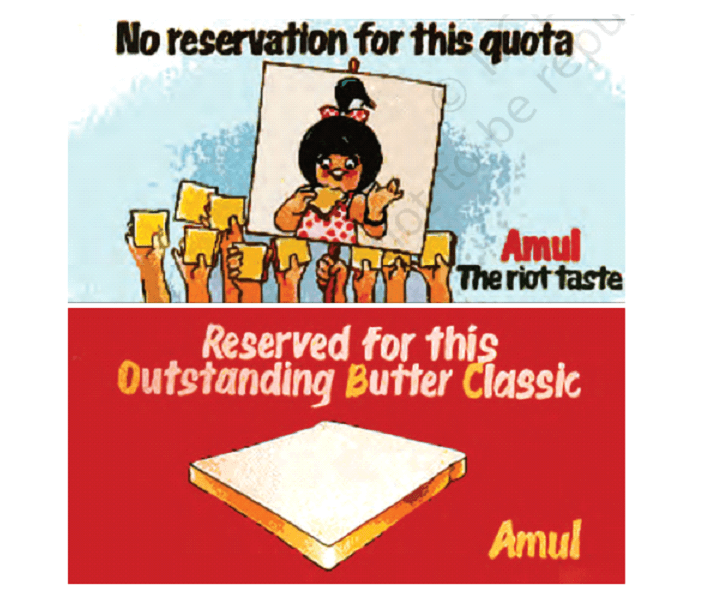
Answer:
The upper hoarding mentions, "No reservation
for this quota .... Amul the riot taste". This refers to the riots which took place when the reservation
quota was made into a law. Similarly, the lower hoarding says, "Reserved for this outstanding Butter
Classic" which again refers to the reservation issue.
Question 6: Who did what in this case of reservations for backward classes?
Answer:
| Supreme Court | Upheld reservations as valid |
|---|---|
| Cabinet | Took the decision to give 27% job reservations |
| President | Made formal announcement about this decision |
| Government officials | Implemented the decision by issuing an order |
Question 7: Which institutions are at work in the running of your school? Would it be better if one person alone took all the decisions regarding management of your school?
Answer:
There are different institutions like Principal's office, the school's administrative office with different departments like sports department, medical room, library and teachers can be considered the institutions of the school which perform different functions. It would not be good if one person takes all the decisions regarding the management of our school because a large number of activities are going on all the time.
It is not possible for one person to take proper decisions on all issues. Even if one person does
take these decisions, he or she might not be able to take a proper decision as it might be taken in
haste or without understanding its implications.
Question 8: What is the point in having so much debate and discussion in the Parliament when we know that the view of the ruling party is going to prevail?
Answer:
Even though, the decision of the ruling party prevails in Parliament, even then we should have debates and discussions because this helps to bring out the positive and negative points of the issue under consideration. The positive aspects might be adopted by the ruling party, and similarly negative aspects could be omitted even if the entire bill is not changed. This will help in adopting positive ideas by the ruling party which aim for welfare of the people.
Question 9: When Parliament is in session, there is a special
programme everyday on Doordarshan about the proceedings in Lok Sabha and Rajya Sabha. Watch the
proceedings or read about it in the newspapers and note the following:
- Powers of the two Houses of Parliament.
- Role of the Speaker.
- Role of the Opposition.
Answer:
(a) Powers of the Two Houses of Parliament
Details are given in the Constitution. However, we should know that the Lok Sabha members are directly
elected by the voters and so are the final voices in the passing of any laws. The Rajya Sabha members
are indirectly elected or nominated and they function mostly in an advisory capacity. But the consent of
both Houses is required for passing any Bill, making a law, or making amendments to the Constitution.
(b) Role of the Speaker (Lok Sabha)
The Speaker's main functions —
- Regulate the proceedings of the House.
- Maintain discipline in the House.
- Supervise Parliamentary Committees.
- Perform administrative duties like receiving documents, receiving petitions, etc which are addressed to the House.
- Exercise powers under the anti-defection law.
- Exercise other powers as given in the Constitution.
The major function of the opposition is to act as a check on the ruling party so that any faults of theirs are exposed and any mistakes made by the ruling party are corrected. They can even bring a no-confidence motion against the government if it is seen to be not functioning properly.
Question 10: The race to become minister is not new. Here is a cartoon depicting ministerial aspirants waiting to get a berth in Nehru’s Cabinet after the 1962 elections. Why do you think political leaders are so keen to become ministers?
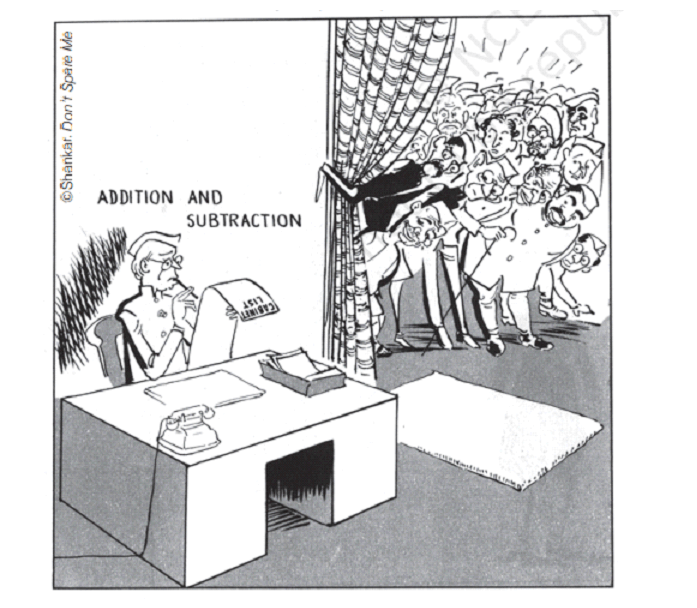
Answer:
Political leaders are keen to become ministers for the following reasons
(a) They want to fulfill the promises made to the electorate at the time of elections. In this way, at
the time of the next election, they will be in a favorable position to win again.
(b) Becoming a minister gives them many additional powers which they would not have if they were only
MPs.
(c) They can fulfill their ambitions and also help many of their family members, associates and friends
by sanctioning various schemes which give benefit to them.
Question 11:
A) List the names of five Cabinet Ministers and their ministries each at the Union level and in your
state.
Answer:
Union Cabinet Ministers
| A) Shri Amit Shah | i) Ministry of Home Affairs ii) Ministry of Cooperation |
|---|---|
| B) Shri Rajnath Singh | Ministry of Defence |
| C) Shri Nitin Jairam Gadkari | Ministry of Road Transport and Highways |
| D) Shri Narayan Tatu Rane | Ministry of Micro, Small and Medium Enterprises |
| E) Smt. Nirmala Sitharaman | i) Ministry of Finance ii) Ministry of Corporate Affairs |
| A) Smt. Nirmala Sitharaman | i) Ministry of Finance ii) Ministry of Corporate Affairs |
|---|---|
| B) Gangapuram Kishan Reddy | i) Ministry of Culture ii) Ministry of Tourism iii) Ministry of Development of North Eastern Region |
B) Meet the Mayor or Municipal Chairperson of your town or the President of Zilla Parishad of your district and ask him or her about how the city, town or district is administered.
Answer:
My city is Kakinada and its Mayor is Sunkara Pavani. She got elected on 29 August 2017.
Kakinada Municipal Corporation is the civic body of Kakinada in the Indian state of Andhra Pradesh.
The jurisdiction of the corporation is spread over an area of 30.51 sq.km and the population as per the 2011 Census of India was 312,538. It started to expand from 1920, when it was only 20.31 sq.km and the population was just over 50,000. The urban agglomeration area of Kakinada is spread over an area of 57.36 sqkm. The urban agglomeration constituents includes the areas of Kakinada municipal corporation, census towns of Chidiga, Ramanayyapeta, Suryaraopeta and the out growths of Ganganapalle, Sarpavaram, Vakalapudi and Turangi.
The sources for revenue generation for Kakinada Municipal Corporation include property tax, user charges for SWM, penalities, rent from municipal properties, income from water storage, water transmission, drainage and sanitation, grants, and charges for services such as birth and death certificates.
The municipal corporation has the following administrative departments:
Health Department, House Tax Department, Engineering Department, Park Department, Advertisement
Department, Accounting Department, Property Department. There is also an Executive Committee made up of
12 elected councillors from different political parties, who decide on policy matters of the
corporation.
Question 12: This cartoon depicts a cabinet meeting chaired by Prime Minister Indira Gandhi in early 1970s, at the peak of her popularity. Do you think similar cartoons could be drawn about other prime ministers who followed her?
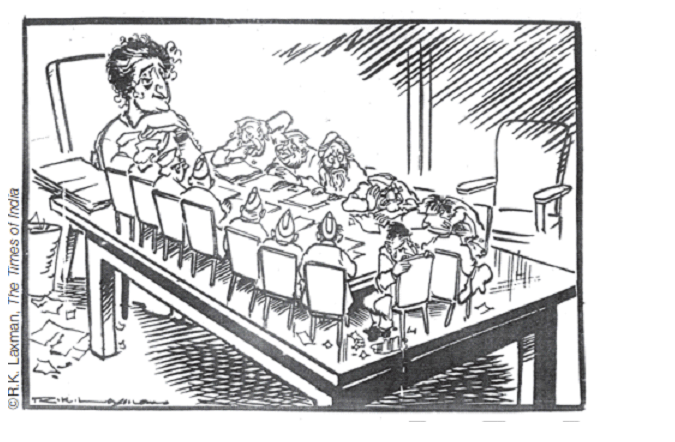
Answer:
No, I do not think that similar cartoons
could be drawn about any other Prime Minister afterwards. She was a dominant personality and
overshadowed everybody else in the Cabinet.
Question 13: Why does this book refer to the President as ‘she’? Have we ever had a woman President in our country?
Answer:
The book refers to the President as 'she' to
show that the highest office in India can also be occupied by a woman. Yes, we have had a woman
President in our country. Pratibha Patil has been the only woman President of our country.
Question 14: Did you protest when the book referred to the Prime Minister as ‘he’? Have we not had a woman Prime Minister? Why should we assume that all the important positions are held by men?
Answer:
No, I did not protest, when the book referred
to the Prime Minister as 'he' because at present we have a male person as a Prime Minister. When we are
referring to the post in general we can use her/him simultaneously to show that the said post can be
occupied by either males or females.
Yes, we should not assume that all important positions are held by men, women too occupy high positions
but that is an exception and not the rule, generally speaking in most of the cases important positions
are indeed occupied by men. There is a need to increase the participation of women in politics by
providing them at least 1/3rd reservation in the State Assemblies and Parliament.
Question 15: What is better for a democracy: A Prime Minister who can do whatever he wishes or a Prime Minister who needs to consult other leaders and parties?
Answer:
Both the extreme cases, one in which the Prime Minister can do whatever he wishes and the second case in
which the Prime Minister has to consult other leaders and parties are not totally correct. If a Prime
Minister is free to do as he wishes, there is a possibility that he might develop authoritarian or
dictatorial tendencies. On the other hand, if all the time he has to consult other leaders and parties,
it would hamper working of the Prime Minister and the government's functioning. Therefore, he should
have freedom of taking decisions but he should also seek the consultation of other leaders and parties
on important issues.
Question 16: Eliamma, Annakutti and Marymol read the section on the
President. Each of them had a question. Can you help them in answering these questions ?
Eliamma: What happens if the President and the Prime Minister disagree about some policy? Does the view
of the Prime Minister always prevail ?
Annakutti: I find it funny that the President is the Supreme Commander of Armed Forces. I doubt if the
President can even lift a heavy gun. What is the point in making the President the Commander ?
Marymol: I would say, what is the point in having a President at all if all the real powers are with the
Prime Minister ?
Answer:
(a) Answer to Eliamma,- The Prime Minister's view prevails. However, if the President does not agree to
some Bill sent for approval, she is empowered to send it back for reconsideration to the Parliament,
giving the reasons for doing so. Now, if the Parliament approves it once again, the President cannot
stop the Bill. She will now have to approve it.
(b) Answer to Annakutti - The Supreme Commander is the one, who gives the orders to fight a war. A
commander is not always required to use firearms; only she should have the wisdom (usually after
consultation with the senior members of the government and armed forces) to issue the necessary orders.
(c) Answer to Marymol - The President is a symbol of the power of the country. The President is required
to take decisions on appointing the Prime Minister, who must have majority support. The President has
many other functions like appointing Governors of States, representing India as Head of State, etc.
Question 17: It is quite common in the US for judges to be nominated on the basis of well-known political opinions and affiliations. This fictitious advertisement appeared in the US in 2005 when President Bush was considering various candidates for nomination to the US supreme court. What does this cartoon say about the independence of the judiciary? Why do such cartoons not appear in our country? Does this demonstrate the independence of our judiciary?
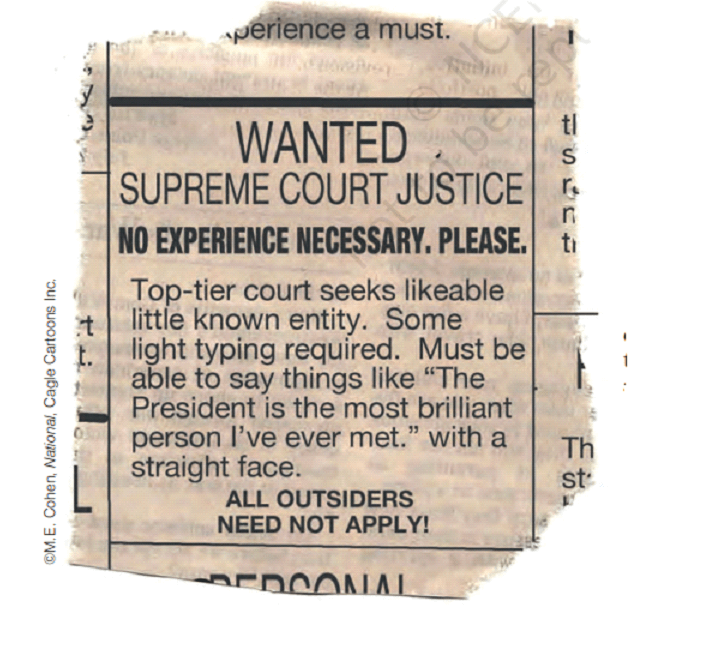
Answer:
(a) It shows that in the USA, the Judiciary is not considered to be independent, in the eyes of the
people. It voices the feeling that justices of the Supreme Court there are appointed on their being
supportive of the President. Their qualifications and experience are not so much important for their
appointment to the US Supreme Court.
(b) Such cartoons do not appear in India because :
- The appointment of justices to the Supreme Court is by a specified procedure which is transparent and does not favour anybody having sympathies with the government.
- Indian judiciary is considered to be among one of the most the independent judiciaries in the world.
- Judges normally do not speak in favour of or against any politician either of the ruling party or the opposition.
Question 18: Follow the news about any major court case in a High Court or the Supreme Court. What was the original verdict? Did the High Court or the Supreme Court change it? What was the reason?
Answer:
The Ayodhya dispute or Ram Janmabhoomi – Babari Masjid Title Dispute is a political, historical and
socio-religious debate that centered on a plot of land in Ayodhya, Uttar Pradesh.
The dispute revolves around the control of a site that is traditionally regarded by the Hindus as the
birthplace of the Hindu deity Rama, the history and location of the Babari Masjid at the site and the
question of whether or not there was previously a Hindu temple that may have been demolished or modified
to create the mosque.
The Babari Masjid was destroyed during a political rally that was turned into a riot on December 6 of
1992.
Following this incident, a land title case was lodged in the Allahabad High Court.
In the judgement on 30th September 2010, the 3 judges of the Allahabad HC ruled that the 2.77 acres of
Ayodhya land be divided into 3 parts, with one-third going to the Ram Lalla or infant Rama as
represented by the Hindu Maha Sabha, one-third going to Sunni Waqf Board and the remaining one-third to
Nirmohi Akhara.
30th September 2010: The Allahabad HC pronounced its verdict on 4 title suits relating to the Ayodhya
dispute on 30th.
December 2010: SC challenged the Allahabad HC’s verdict.
May 2011: The SC stayed the Allahabad HC order of splitting the disputed site into three parts and said
that the status quo will remain.
November 9, 2019, a Supreme Court Bench led by Chief Justice Ranjan Gogoi unanimously ruled that the
disputed land be given to the Ram Janmabhoomi Nyas for the construction of a temple, and the Muslim side
be compensated with five acres of land at a prominent site in Ayodhya to build a mosque.
Question 19: Why are people allowed to go to courts against the government’s decisions?
Answer:
Sometimes, the actions of the government or
a law passed by the government might hurt the public interest or might be against the spirit of the
Constitution. In such cases, citizens have the right to go to court to get justice. Such cases are
called Public Interest Litigations. (PILs)
- In case of violation of Fundamental Rights by the government, the citizen can go to the courts for justice.
- The Right to Constitutional Remedies provides that if the Fundamental Rights are violated, the citizen can go to court to seek a remedy.
Question 20: Give one reason each to argue that Indian judiciary is
independent with respect to:
Appointment of judges: …
Removal of judges: …
Powers of the judiciary: …
Answer:
(a) Appointment of Judges: The judges of the
Supreme Court and the High Courts are appointed by the President on the recommendation of the Prime
Minister and in Consultation with the Chief Justice of India. In actual practice, the senior judges of
the Supreme Court select new judges for the Supreme Court as well as for the High Courts. Here seniority
and merit are the main considerations with hardly any scope for manipulation by anybody.
(b) Removal of Judges: The procedure of removal of judges of the Supreme Court and High Courts is very
difficult to actually carry out. They can be removed only on the basis of an impeachment motion passed
by two-thirds majority in both Houses of Parliament separately. So removal of judges cannot be done
arbitrarily.
(c) Powers of the Judiciary: The powers are clearly spelt out in the Constitution and they cannot be
diluted by Parliament or by any Presidential order. So no politician can reduce or increase their
powers. The Supreme Court has the power to declare illegal any law made by Parliament if it goes against
the Constitution.
Exercises
Question 1: If you are elected as the President of India which of
the following decision can you take on your own?
(a) Select the person you like as Prime Minister.
(b) Dismiss a Prime Minister who has a majority in the Lok Sabha.
(c) Ask for reconsideration of a bill passed by both the Houses.
(d) Nominate the leaders of your choice to the Council of Ministers
Answer:
(c) Ask for reconsideration of a bill passed by both the Houses.
Question 2: Who among the following is a part of the political
executive?
(a) District Collector
(b) Secretary of the Ministry of Home Affairs.
(c) Home Minister
(d) Director General of Police
Answer:
(c) Home Minister
Question 3: Which of the following statements about the judiciary
is false?
(a) Every law passed by the Parliament needs approval of the Supreme Court
(b) Judiciary can strike down a law if it goes against the spirit of the Constitution
(c) Judiciary is independent of the Executive
(d) Any citizen can approach the courts if her rights are violated.
Answer:
(a) Every law passed by the Parliament needs approval of the Supreme Court
Question 4: Which of the following institutions can make changes to
an existing law of the country?
(a) The Supreme Court
(b) The President
(c) The Prime Minister
(d) The Parliament
Answer:
(d) The Parliament
Question 5: Match the ministry with the news that the ministry may have released:
| a) A new policy is being made to increase the jute export from the country | i) Ministry of Defence |
|---|---|
| b) Telephone services will made more accessible to rural areas | ii) Ministry of Agriculture . Food and Public Distribution |
| c) The price of rice and wheat sold under the public Distribution system will go down | iii) Ministry of Health |
| d) A pulse polio campaign will be launched | iv) Ministry of Commerce and Industry |
| e) The allowance of the soldiers posted on high altitude will be increased | v) Ministry of communications and information technology |
Answer:
(a) - (iv), (b) - (v), (c) - (ii), (d) - (iii), (e) - (i)
Question 6: Of all the institutions we have studied in this
chapter, name the one that exercises the powers on each of the following matters.
(a) Decision on allocation of money for developing infrastructure like roads, irrigation etc. and
different welfare activities for the citizens
(b) Considers the recommendation of a Committee on a law to regulate the stock exchange
(c) Decides on a legal dispute between two state governments
(d) Implements the decision to provide relief for the victims of an earthquake
Answer:
(a) The prime minister and the Council of Ministers
(b) The Parliament
(c) Supreme Court of India
(d) The Civil Servants working together.
Question 7: Why is the Prime Minister in India not directly elected
by the people? Choose the most appropriate answer and give reasons for your choice.
(a) In a Parliamentary democracy only the leader of the majority party in the Lok Sabha can become the
Prime Minister.
(b) Lok Sabha can remove the Prime Minister and the Council of Ministers even before the expiry of their
term.
(c) Since the Prime Minister is appointed by the President there is no need for it.
(d) Direct election of the Prime Minister will involve a lot of expenditure on elections.
Answer:
(a) Elections are not fought for the post of
the Prime Minister. Only parties fight elections and the majority party’s leader becomes the Prime
Minister. In a Parliamentary democracy, only the leader of the majority party in the Lok Sabha can
become the Prime Minister.
Question 8: Three friends went to watch a film that showed the hero becoming Chief Minister for a day and making big changes in the state. Imran said this is what the country needs. Rizwan said this kind of a personal rule without institutions is dangerous. Shankar said all this is a fantasy. No minister can do anything in one day. What would be your reaction to such a film?
Answer:
While it may look quite appealing in a
movie; the real life is strikingly different. Governance in a democracy is all about taking everyone
along with you. Moreover, in a large and diverse country like India, it is not possible to take decision
on the whims of an individual. Implementation of a decision needs to coordination among various organs
of the government and a minister is just a part of that system.
Question 9: A teacher was making preparations for a mock Parliament. She called two students to act as leaders of two political parties. She gave them an option: Each one could choose to have a majority either in the mock Lok Sabha or in the mock Rajya Sabha. If this choice was given to you, which one would you choose and why?
Answer:
I would act as leader from ruling party. I would like to be in majority in Loksabha and take all legislative decisions. Governance in a democracy means taking everyone along with you. In addition, in a vast and diverse country like India, it is very difficult to consider only an individual’s decision. Moreover, decision implementation needs to be coordinated among various organs of the government.
Question 10: After reading the example of the reservation order,
three students had different reactions about the role of the judiciary, which view, according to you, is
a correct reading of the role of the judiciary?
(a) Srinivas argues that since the Supreme Court agreed with the government, it is not independent.
(b) Anjaiah says that the judiciary is independent because it could have given a verdict against the
government order. The Supreme Court did direct the government to modify it.
(c) Vijaya thinks that the judiciary is neither independent nor conformist, but acts as a mediator
between opposing parties. The court struck a good balance between those who supported and those who
opposed the order.
Answer:
Anjaiah’s view on the role of judiciary is
correct because judiciary is independent and impartial. It is not under the control of the legislature
or the executive. The judges do not act on the direction of the government or according to the wishes of
the party in power.